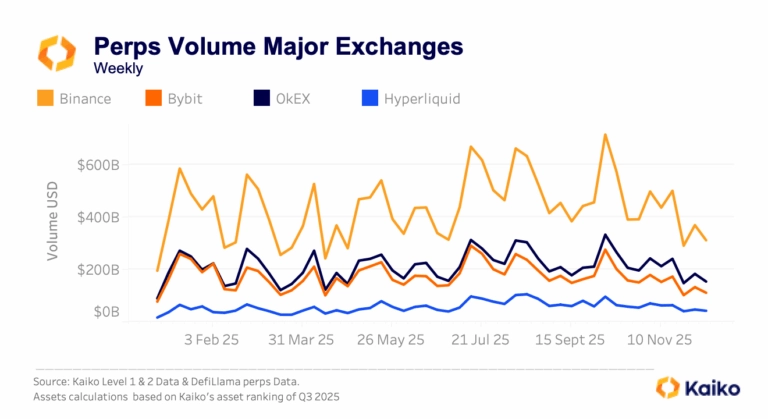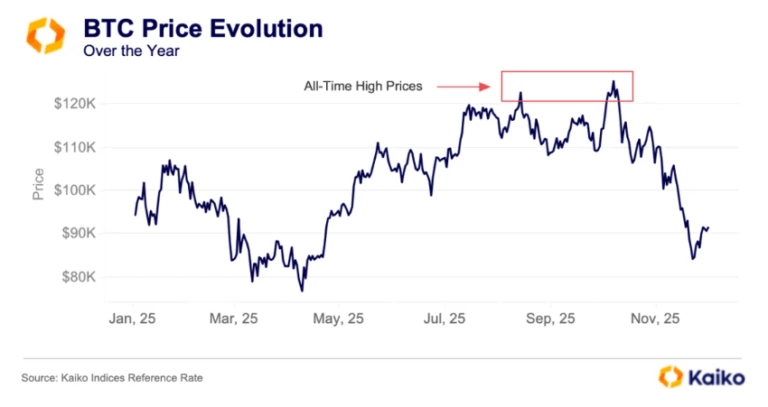Liquidity Flywheel Drives Binance to 300 Million Users

Binance halts withdrawals as BTC fees surge

Welcome to the Data Debrief!
Bitcoin closed the week in the red after network congestion led Binance to halt withdrawals twice over the past 48 hours, the U.S. Fed hiked rates but opened the door for a pause amid lingering banking turmoil, Coinbase reported smaller than expected loss in the first quarter while Bittrex filed for bankruptcy.
-
Rising BTC fees impacting withdrawals on Binance and prices on Binance.US.
-
Effects of Terra’s collapse one year later.
-
U.S. exchanges lagging in volume growth year to date.
-
The share of ETH call option volume rises.
Trend of the Week
Binance halts withdrawals as BTC fees surge.
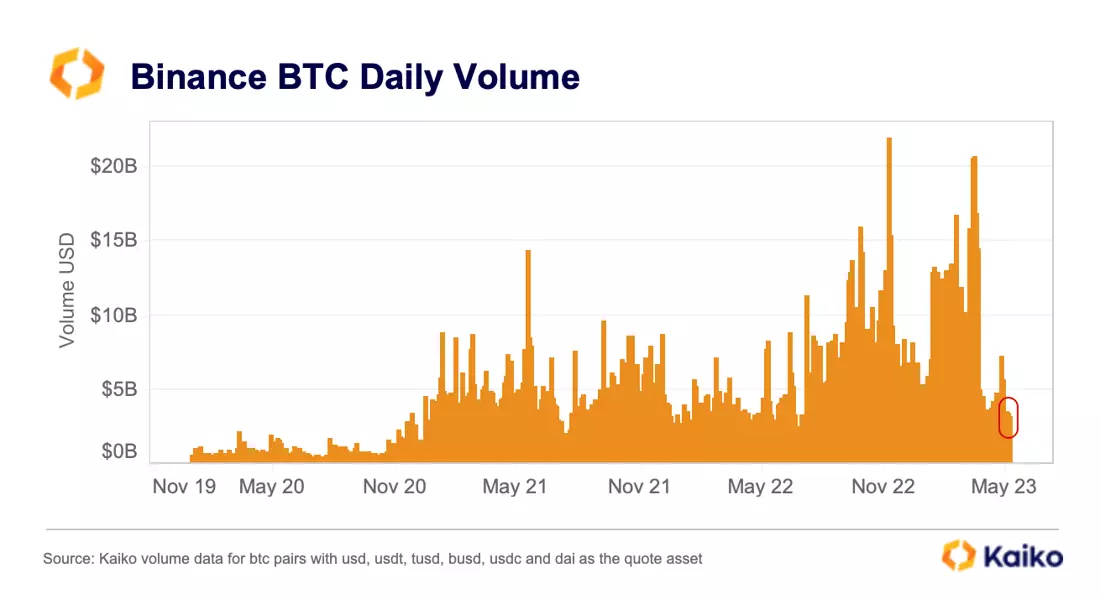 The rise in popularity of BRC-20 tokens, essentially memecoins on the Bitcoin blockchain, has pushed Bitcoin fees to 2 year highs. BRC-20s have massively increased demand for Bitcoin blockspace for the first time in recent history, with the network suffering from congestion and unconfirmed transactions as a result. Over the weekend, Binance had to pause BTC withdrawals twice as they hadn’t accounted for a surge in BTC fees in the amount they pay miners, which had caused many transactions to go unconfirmed. Other exchanges were able to process BTC transactions, making this a Binance-specific issue. BTC volumes on the exchange barely spiked at all, meaning this wasn’t driven by any particular worries about Binance, as was the case in December.
The rise in popularity of BRC-20 tokens, essentially memecoins on the Bitcoin blockchain, has pushed Bitcoin fees to 2 year highs. BRC-20s have massively increased demand for Bitcoin blockspace for the first time in recent history, with the network suffering from congestion and unconfirmed transactions as a result. Over the weekend, Binance had to pause BTC withdrawals twice as they hadn’t accounted for a surge in BTC fees in the amount they pay miners, which had caused many transactions to go unconfirmed. Other exchanges were able to process BTC transactions, making this a Binance-specific issue. BTC volumes on the exchange barely spiked at all, meaning this wasn’t driven by any particular worries about Binance, as was the case in December.
In potentially related news, BTC is trading at a 2.5% premium on Binance.US compared with other U.S. exchanges. This has many people speculating that market makers or insiders on Binance.US have received word that the exchange might face imminent legal action, and are looking to trade into BTC to move funds off the exchange.
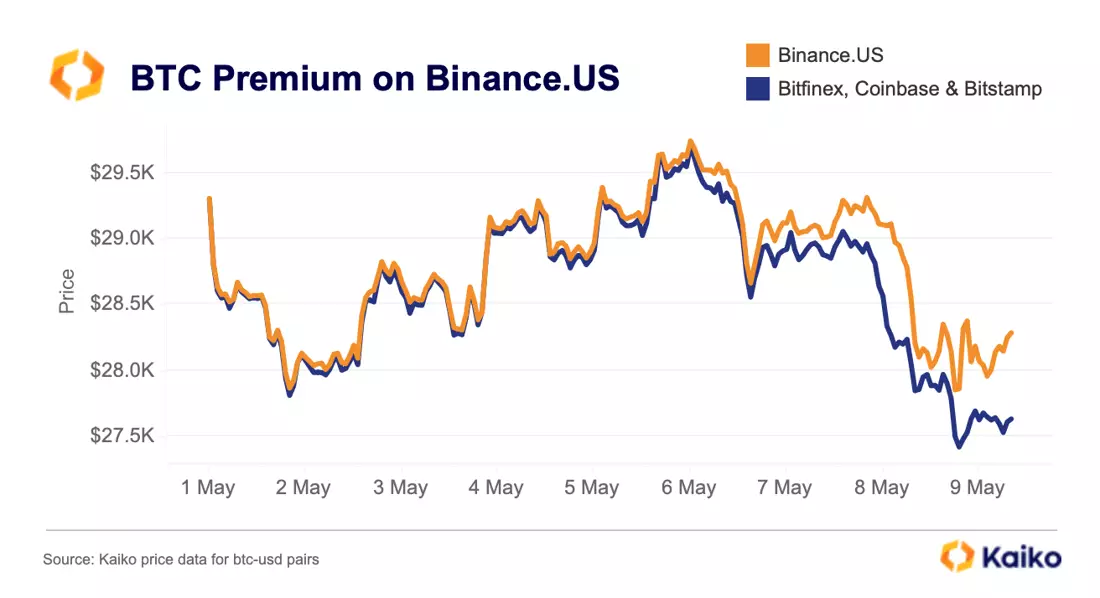
However at the moment these are just rumors, as evidenced by the lack of a change in market depth on Binance.US. If there was a big market maker leaving the exchange, we would see an immediate drop in market depth on the exchange.
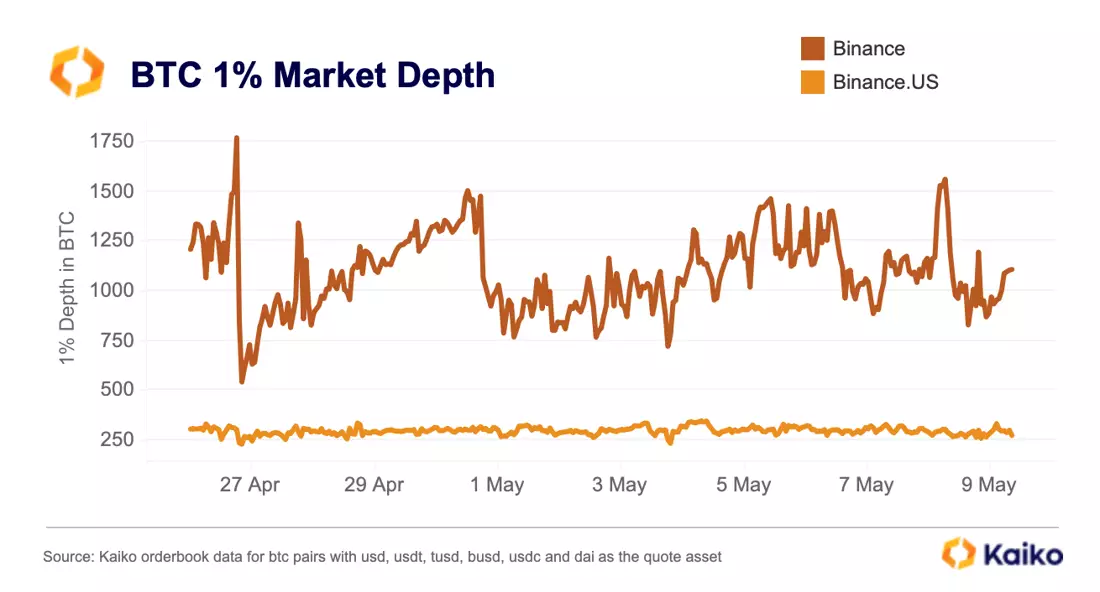
The premium on Binance.US is more likely related to the exchange’s struggles to find a banking partner since the closure of Signature and Silvergate. With a surging demand for BTC generally, investors on Binance.US are likely looking at quicker withdrawal times for BTC compared to USD, and are rushing to trade into BTC at the same time, resulting in a premium on the exchange. This is a symptom of an illiquid market.
Never miss an analysis.
Subscribe to our free weekly Data Debrief email, or learn more about our premium research subscriptions here.
Price
SUI price holds steady then drops following launch.
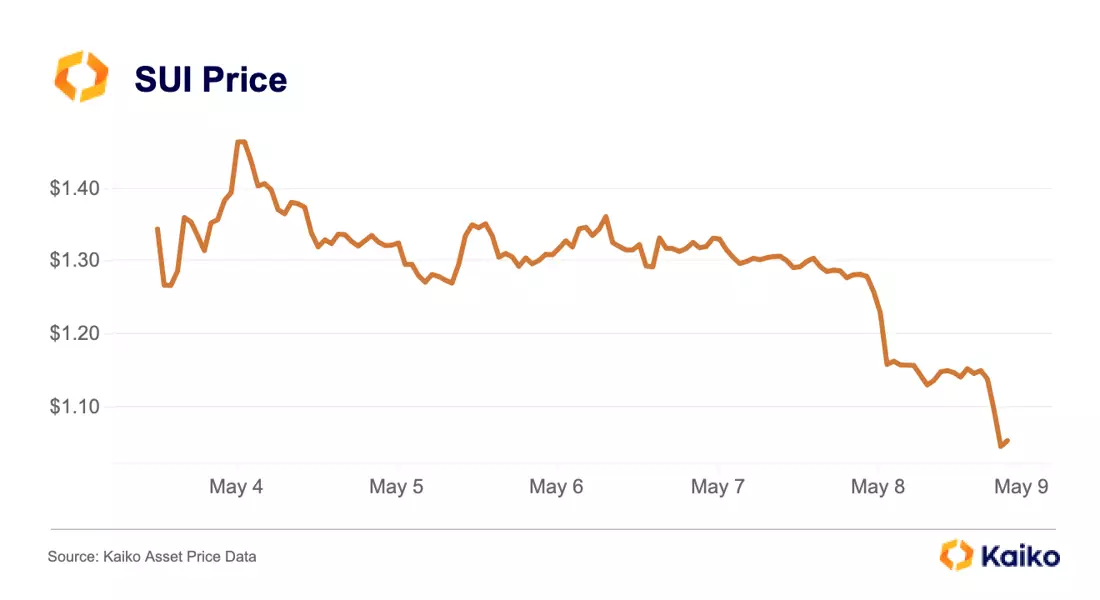
Sui, a new Layer 1 blockchain, went live last week. The network is known for incorporating elements of Meta’s abandoned Diem project, which sought to create a stablecoin backed by a basket of currencies but was subject to significant regulatory scrutiny. Sui uses the Move language, which is based on Rust and was specifically designed by Meta for Diem. In September 2022, Mysten Labs raised $300mn in a Series B round led by FTX Ventures to fund development of the network. The price of the SUI token has fallen since launch, resting below $1.10 as of this writing, giving the network a market cap of $600mn and a fully diluted valuation of $11bn.
Bitcoin Kimchi Premium declines since 2021.
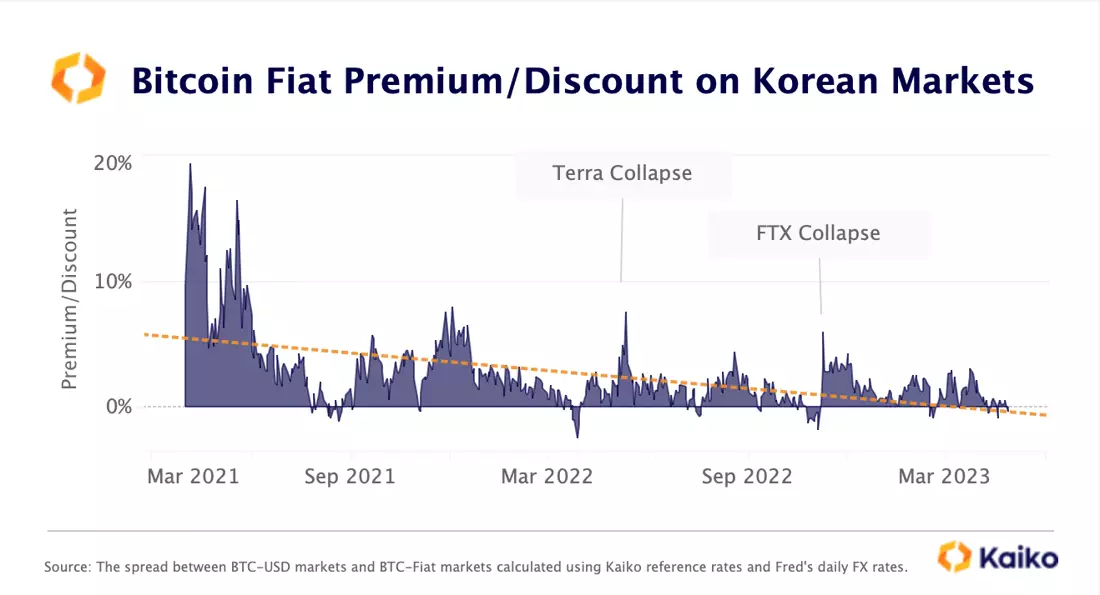
Bitcoin’s Kimchi premium – the gap between Bitcoin prices on Korean markets and other global exchanges – has declined over the past two years, from 20% in April 2021 to an average of 2-3% in 2023. In 2022, this trend coincided with a steady drop in trade volumes on Korean exchanges, indicating subdued overall demand. Trade volumes on the four major Korean markets – Bithumb, Korbit, Coinone, and Upbit – did recover from a two-year low in 2023, surging by 29% in Q1 compared to Q4 of 2022. However, the increase was mainly driven by altcoins, while BTC lagged behind. This could explain why the Kimchi premium remains relatively low, fluctuating between a negative 1% and a positive 3%.
Interestingly, the premium spiked to 7% in May 2022 after the collapse of Terra and to 6% during the collapse of FTX, suggesting that demand for BTC increases during market shocks.
SOL tops the list of best performers in risk adjusted terms.
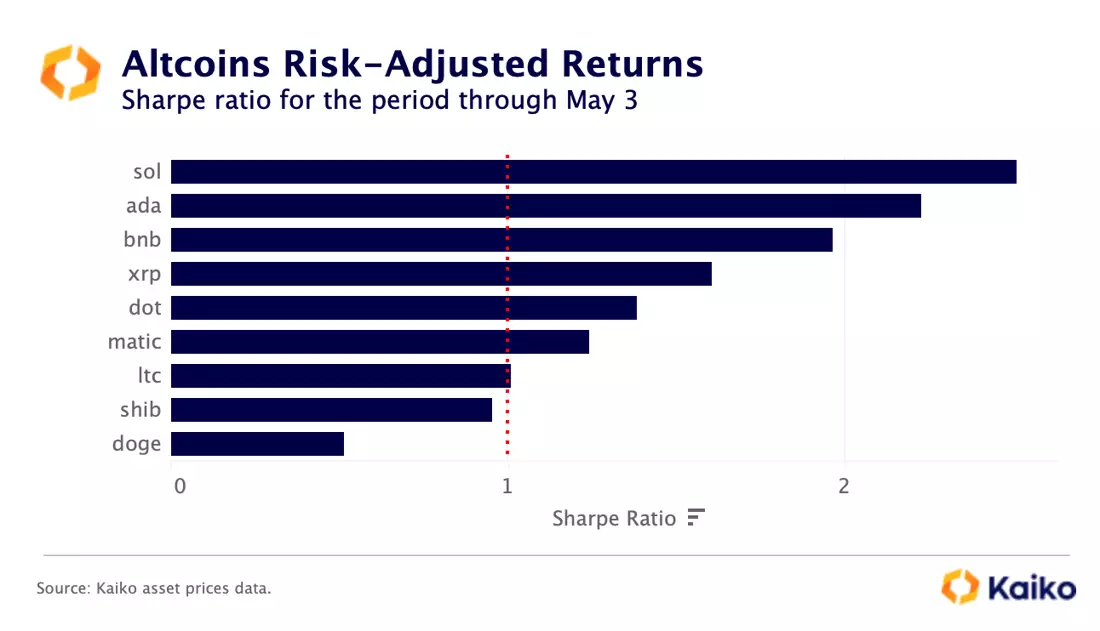
Among the top altcoins by market cap, Solana’s SOL, Cardano’s ADA, and Binance’s BNB have registered the highest year-to-date risk-adjusted returns, as measured by the Sharpe ratio. The Sharpe ratio measures the excess return of an asset per unit of volatility, with a ratio of 1 or above generally considered good. In contrast, meme tokens like Dogecoin and Shiba Inu have been the worst performers, with a ratio below 1. This implies that meme coin investors are taking on more risk relative to the compensation received.
Liquidity
Effects of Terra’s collapse are still being felt one year later.
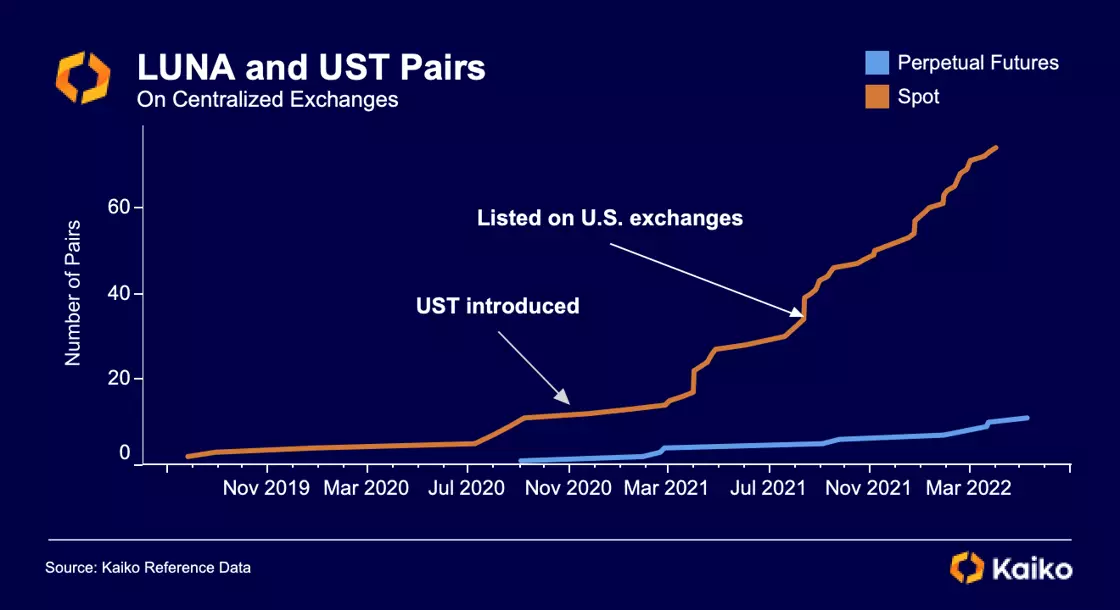
The Terra ecosystem began as a small and under-the-radar project primarily operating in Korea, offering its KRW stablecoin for use in the payments app Chai. This all changed in the Fall of 2020 with the creation of UST, the now-infamous U.S.-dollar stablecoin that depegged in dramatic fashion in May 2022. UST’s growth was supercharged by Anchor Protocol, which offered nearly 20% APY on deposits of the token, making yield generation the stablecoin’s top use case. LUNA and UST were not listed on top U.S. exchanges until late 2021, when LUNA’s price had already surged from under $1 to over $25.
Over the next year, the tokens’ market caps continued to surge, with LUNA hitting an all-time high of over $40bn in April 2022. UST hit nearly $19bn and Terra founder Do Kwon was aiming to dethrone DAI as the top DeFi-native stablecoin.
The crash on May 8, 2022 created ripple effects that are still unfolding. Namely, by bringing prices down, it exposed unhealthy business models, ultimately culminating in FTX’s collapse. As Terra collapsed, BTC liquidity plummeted from $210mn to $120mn, in large part influenced by BTC’s price.
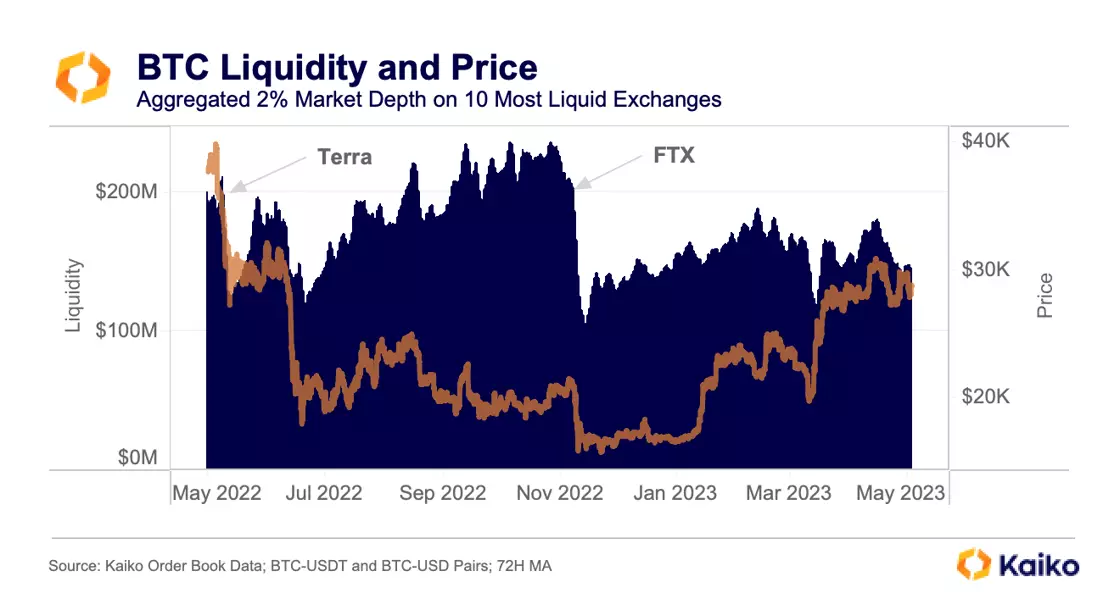
Liquidity actually recovered independent of price in late May before Celsius and other CeFi companies began to collapse. Liquidity again recovered while price trended downwards, only to be undone by FTX. Thus it’s fair to say that Terra was not directly responsible for current illiquidity, but was rather the first domino that exposed riskier and riskier actors, eventually taking out FTX and Alameda.
U.S.-based exchanges lag in volume growth.
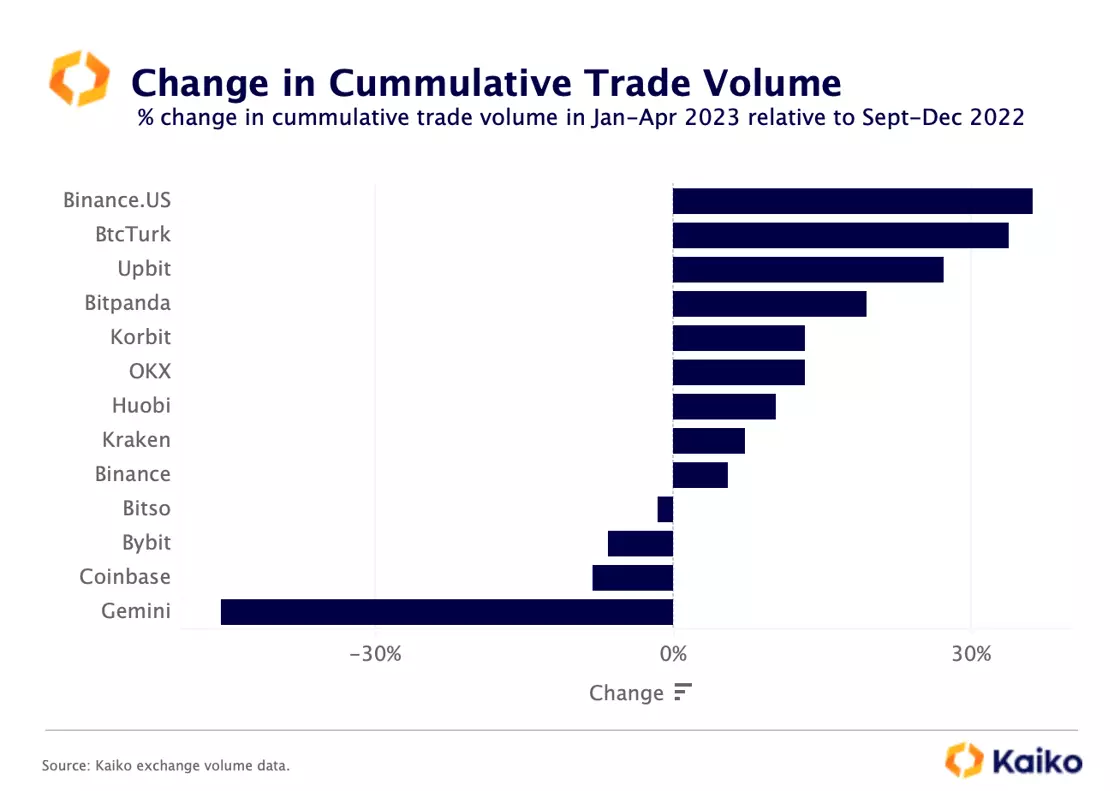
Binance.US, the U.S. arm of the global crypto exchange Binance, recorded the strongest increase in trade volume in the first four months of 2023 compared to the previous four-month period, despite reportedly facing challenges in finding a banking partner after the collapse of Signature Bank and Silvergate in early March. To attract customers, the exchange maintained zero-fees for BTC and ETH pairs while its global affiliate Binance experienced a plummet in trade volume after removing its nine-month-long zero-fee promotion for BTC pairs.
Trade volume on Turkish crypto platform BtcTurk rose by 34% due to increased demand for stablecoins amid inflation and political uncertainty ahead of the country’s general elections. Upbit, the largest Korean exchange, and EU-based Bitpanda also registered strong double-digit increases in trade volume in Jan-April, likely benefiting from the regulatory crackdown in the U.S.
In contrast, trade volume declined for U.S.-based exchanges, such as Coinbase and Gemini, while Kraken’s volume increased modestly by 5%. The worsening regulatory environment in the U.S. has limited the ability of U.S.-based exchanges to launch new products locally, potentially impacting revenue diversification strategies. However, Coinbase’s recent earnings call showed lower-than-expected losses in Q1 of $79mn, partially due to strong institutional revenue on its prime platform, which hit an all-time high.
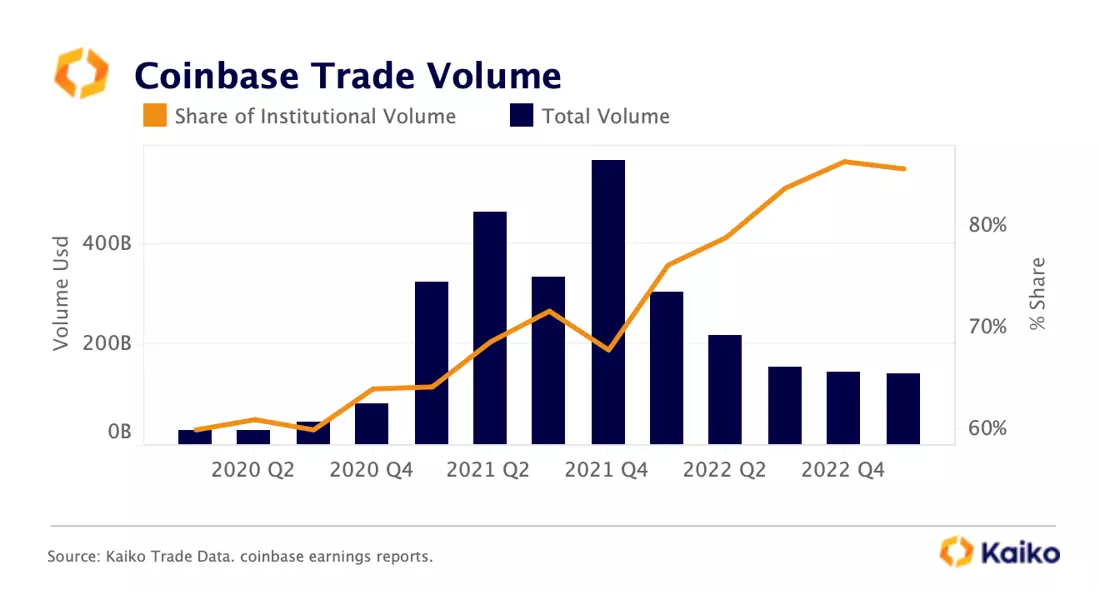
Interestingly, even though the increase in revenue resulted from the rollback of market makers discounts, the overall share of institutional trading volume remained resilient, hovering above 85%. This suggests that the exchange may have increased its pricing power (i.e., ability to increase prices without affecting demand). While other exchanges faced operational difficulties following the collapse of Silvergate and Signature, Coinbase quickly replaced lost banking services and resumed offering 24/7 instant settlement, crucial for market makers.
Uniswap average trade size falls as memecoin mania takes hold.
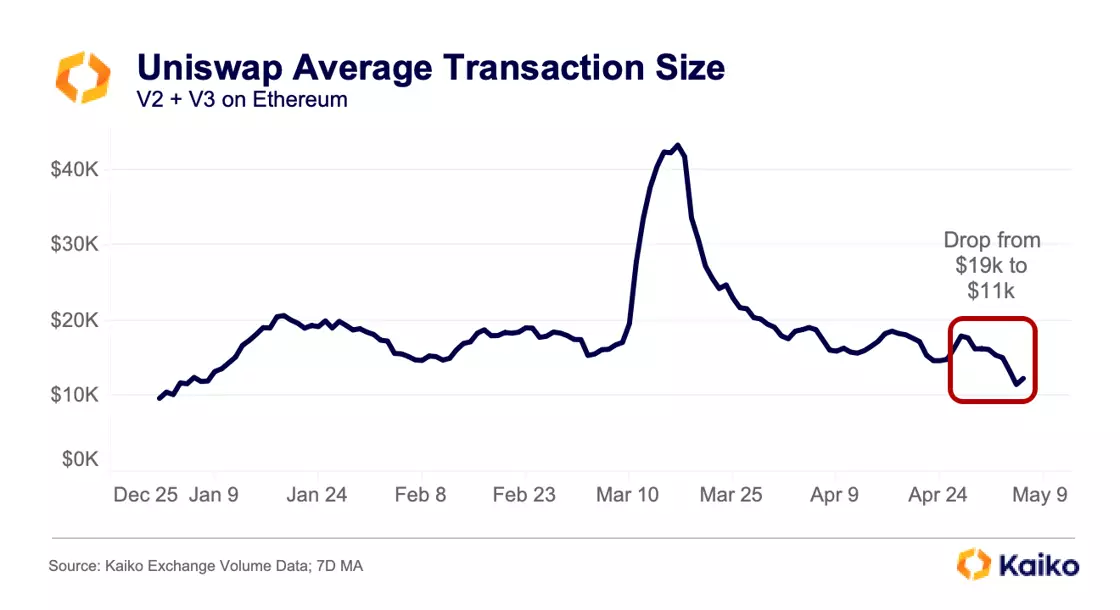
The average trade size on Uniswap has fallen to its lowest level since the beginning of the year as trading of meme tokens like PEPE has become the dominant activity on Ethereum. The flurry of activity has also caused gas prices to hit levels not seen since Terra’s crash, making it expensive for users to transact on the network. The high cost of gas is likely the reason the average trade size has not dropped even further, as fees in excess of $15 make trading less profitable for all users, but particularly retail users who are trading smaller size. This cost has driven much of the more speculative retail activity to L2s and other networks.
Implied Volatility
Surfaces Now Live
Kaiko’s IV surface data follows the launch of IV Smiles last year. The new addition includes space and time interpolation, enabling even more precise and complete analysis for clients. The product now has the ability to provide accurate volatility for a range of expiry dates and strike prices, even those not listed.
-
introduction of multi-source aggregation
-
more robust and manipulation-resistant, using a trusted transparent methodology
-
advanced algorithms and new interpolation framework
-
stay ahead of market trends & make informed trading decisions
Derivatives
The share of call volumes increases on ETH market.
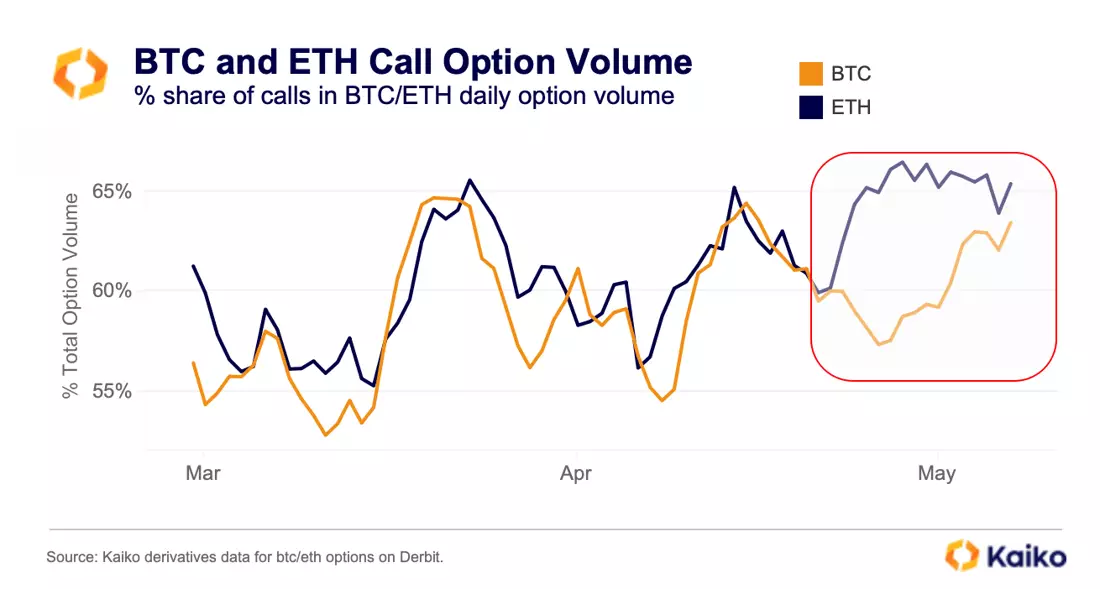
The share of call option trade volume (bullish bets) on ETH markets has increased in the weeks following the Shapella upgrade and hovers around a yearly high of 67% reached at the end of April suggesting sentiment remains mostly bullish. While both BTC and ETH option volumes have been dominated by calls this year, the share of bullish bets on BTC markets has fallen from 70% hit mid-January to 63% as of early May. Overall, both BTC and ETH option volume have lost steam after hitting their highest level since the collapse of FTX in early March.
Macro
U.S. Fed hikes rates but opens the door for a pause amid banking turmoil.
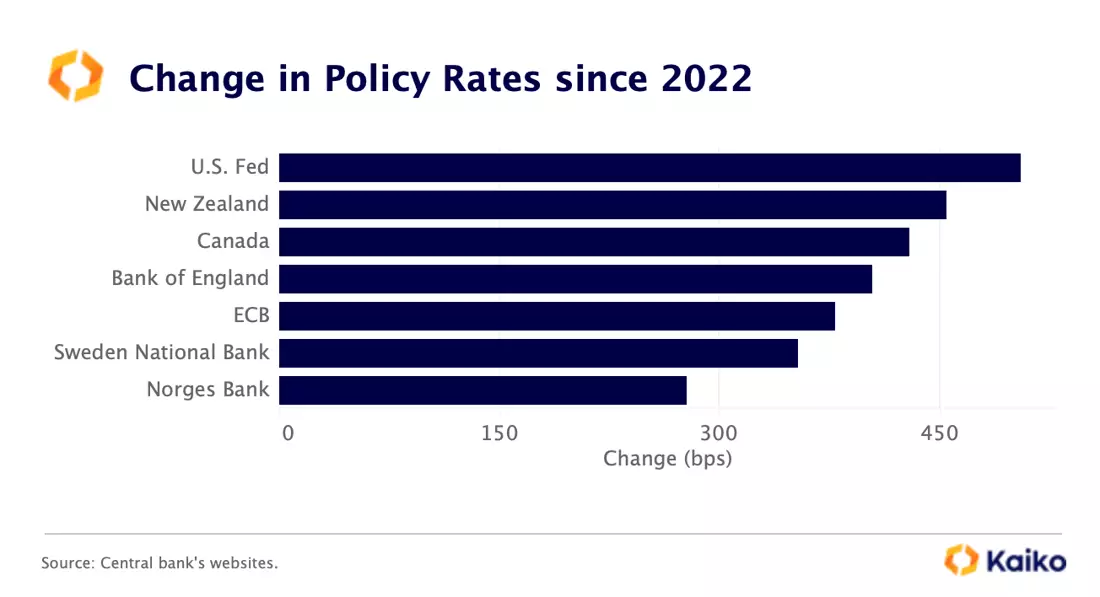
The U.S. Federal Reserve raised rates by 25 basis points last week and signaled a potential pause in monetary policy tightening due to concerns around the widening U.S. regional banking crisis. The Fed is currently the most hawkish central bank among developed countries, with a cumulative increase of 500 bps in rates since the start of 2022, compared to New Zealand’s 454 bps and Canada’s 429 bps.
While the pause in rate hikes may provide some relief for risk assets, the Fed emphasized that any future decision will depend on economic data, making abrupt shifts in market sentiment following data releases even more likely now. Economic data has been volatile, contributing to increased intraday volatility for both crypto and traditional assets. Inflation has been particularly difficult to predict, with a growing consensus that it is mostly profit-led, meaning it could decline faster than wage-led inflation. Furthermore, markets are increasingly difficult to influence, as evidenced by current expectations for rate cuts starting in September, despite the Fed pushback.

Data Used in this Analysis
Derivatives Metrics
![]()
Metrics and analytics products tailored to the cryptocurrency derivatives market.
Liquidity Metrics
![]()
The most granular order book data in the industry optimized for quantitative analyis.
Trade Volume
![]()
Centralized exchange data sourced from the most liquid venues, covering all traded instruments.
More From Kaiko Research
![]()
Derivatives
22/12/2025 Data Debrief
Crypto in 2026, What Breaks, What Scales, What ConsolidatesCrypto markets enter 2026 in a markedly different position than in prior cycle transitions. Rather than resetting after a speculative peak, the market appears to be progressing through a phase of institutional consolidation.
Written by Thomas Probst![]()
Year in Review
01/12/2025 Data Debrief
Kaiko Research's Top 10 Charts of 2025In this report, we look back on 2025 and the key forces that shaped markets. From BTC record highs and fleeting altcoin rallies to major liquidation events and evolving regulation, we examine what shaped a seminal year for crypto.Written by Adam Morgan McCarthy![]()
Stablecoin
24/11/2025 Data Debrief
MiCA's Impact on Crypto in EuropeEurope is progressing with a conservative structured crypto framework that leans towards regulating innovation.Written by Adam Morgan McCarthy![]()
Macro
17/11/2025 Data Debrief
Navigating Fed Fears & AI Bubble BurstingGiven the current macroeconomic context, we are seeing the emergence of two major risks likely to have a decisive impact.
Written by Adam Morgan McCarthy





